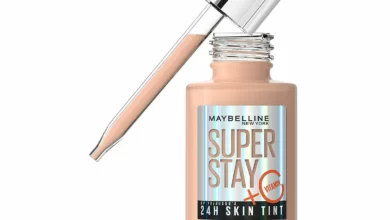I Tried a 2-Step Skin Routine—Here’s How It Held Up| Well+Good

Before embarking on my experiment, I chatted with esthetician and content creator Tiara Willis as well as board-certified dermatologist Aegean Chan, MD, to get their predictions and to ask which products my skin could (and couldn’t) go without.
Dr. Chan is a sunscreen soldier. “I wouldn’t even include sunscreen as part of the lineup,” she says. “Sunscreen is such an essential, so I don’t even think of that as part of the skin-care routine.” Putting on sunscreen is something you should be doing anyway, so it’s not a step. It’s more like taking a shower or brushing your teeth—it’s simply a given, says Dr. Chan.
Even though Dr. Chan makes a great point, I decided that I wanted to stick true to just two steps, using two products—which were cleansing and using a moisturizer with SPF. (Sneaky, huh?)
Keep reading to learn what my skin-care routine previously looked like and the disappointing-but-not-surprising results of my month-long skin-care trial.
Cutting down on products
My daily skin-care routine was previously six steps, which Dr. Chan pointed out “was already pretty basic.” Every morning after my run, I gently cleansed my face using CeraVe Hydrating Cleanser ($18), glamorously misted my skin with the Heritage Rose Water & Glycerin Toner ($12), slowly slathered on the tried-and-true Pond’s Clarant B3 Correcting Cream ($12), and confidently topped everything off with two-fingers worth of Neutrogena’s Ultra Sheer Dry-Touch Sunscreen ($8).
At night, I followed the same ritual, replacing my SPF with CeraVe’s Healing Ointment ($25) to lock in moisture, which is a tip I learned from Willis many moons ago. This has become one of my favorite products of all time, so I knew it’d be hard to let it go.
Once a week, I also used Nuria Defend Face Exfoliator ($18) to remove dead skin. Both Dr. Chan and Willis hypothesized that I’d notice more texture on my skin after I removed this product. They also agreed, though, that it wasn’t completely necessary.
“I always tell people, like if they’re trying to get their mom or boyfriend to do a skin-care routine, that they only need three steps,” says Willis, adding that it’s “a cleanser, moisturizer, and SPF.”
I immediately stashed my toner and, with a broken heart, also put away the healing ointment.
Neither expert was thrilled that I would be using an SPF during my nighttime routine. “Technically, you’re using sunscreen at night,” says Willis. “This might not be ideal because it’s a waste of money and may clog your pores.”
Aside from that, though, they didn’t see a huge problem with my newly manicured routine. They thought it would be effective, even if it meant that my skin wouldn’t be as hydrated or as dewy as it once was.
How my skin reacted to a two-step skin-care routine
My two steps? One: Cleansing, which I did post-exercise and pre-bedtime using the CeraVe Hydrating Cleanser. Two: Moisturizing multiple times a day, applying and reapplying Garnier’s Pinea-C Brightening Serum Cream with SPF 30 ($22).
I embarked on this minimalist journey for a month, at the behest of Dr. Chan and Willis, who agreed that having more data points would be ideal. “For this type of experiment, I think it’s less of an immediate result because you are taking away some active ingredients as well,” says Dr. Chan. “I’d do it for at least a few weeks.”
And, honestly, I’m glad I heeded their advice.
The first week of the experiment, I was on a work trip in Hawaii, so my skin wasn’t missing much of the moisture that’s typically provided by my “very hydrating routine.” (Willis’s words!) Willis adds that “Because of the humidity in Hawaii, the air is saturated in water, and this helps maintain hydration in the skin.”
But pretty much as soon as my six-hour flight landed in Los Angeles, which kicked off week two of this trial, my skin started feeling a little tight and not buttery to the touch. “The air inside the airplane has the tendency to make the skin dry because it’s cold and has low humidity,” says Willis.
After a few days of being home, my skin didn’t immediately return to its hydrated state. “If the weather in LA also lacked humidity, your skin is likely to lose moisture because dry air will take moisture where it can get it,” Willis says. It was pretty dry back in LA, so Willis’s theory tracks.
As the days and weeks went on, I noticed that I got a few pimples on my chin as well as on my forehead, which could easily be due to the lack of hydration and moisture. I also realized that, for the same reason, my skin felt very tight and I found myself needing to moisturize more throughout the day—which was new for me.
Once everything was said and done, I can’t say that I loved the mega-minimalist routine. As Willis and Dr. Chan had predicted, my skin was less dewy and less glowy than it had ever been. And yes, I saved a bit of time by cutting down on four steps, but the payoff was just not worth it.
The best way to craft a minimalist routine that actually works
Though using two products may be too minimal to give your skin the nourishment it needs, there’s still a way to craft a routine that’s big on benefits and short on produts and time. In the morning, derms recommend washing your face and using a moisturizer like the Garnier Serum Cream that’s got both antioxidant and SPF protection (that way you’re protected against everyday environmental stressors and UV damage), then swapping in a heavier cream, like my all-time favorite CeraVe healing ointment, for extra hydration at night.
From there, you can (but don’t have to!) add supplemental products to target specific concerns: A niacinamide serum in the morning for brightening dark spots, a retinoid at night for fending off acne and fading fine lines, a hyaluronic acid serum whenever you need hydration, and an exfoliating acid once a week to clear out your pores and resurface your complexion.
The takeaway? Less can be more, as long as you’re listening to your skin.
Our editors independently select these products. Making a purchase through our links may earn Well+Good a commission.

